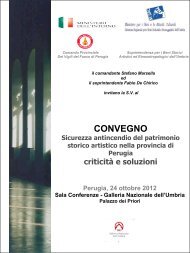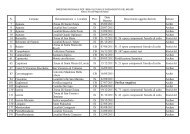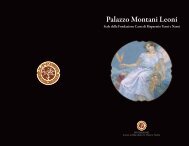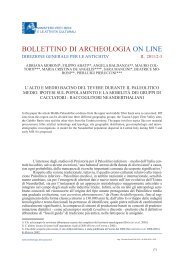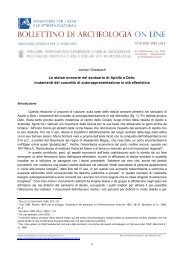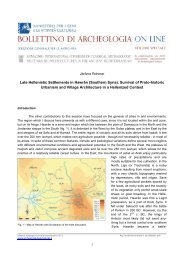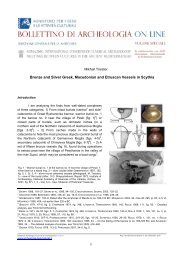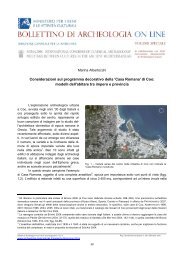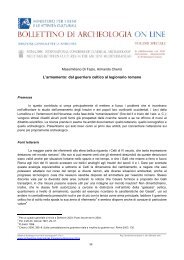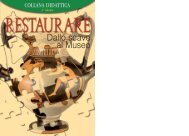Indigenous Settlements and Punic Presence in Roman Republican ...
Indigenous Settlements and Punic Presence in Roman Republican ...
Indigenous Settlements and Punic Presence in Roman Republican ...
You also want an ePaper? Increase the reach of your titles
YUMPU automatically turns print PDFs into web optimized ePapers that Google loves.
R. Colombi - <strong>Indigenous</strong> <strong>Settlements</strong> <strong>and</strong> <strong>Punic</strong> <strong>Presence</strong> <strong>in</strong> <strong>Roman</strong> <strong>Republican</strong> Northern Sard<strong>in</strong>ia<br />
Along the same coast, around 1 kilometre SW of the village, a prestigious villa also stood, which was<br />
decorated with stuccos <strong>and</strong> mosaic floors dated to the 1 st century CE 38 . The whole Sant’ Imbenia site<br />
<strong>in</strong>clud<strong>in</strong>g the Nuragic village <strong>and</strong> its nuraghe, the <strong>Roman</strong> villa <strong>and</strong> a late <strong>Roman</strong>-early Medieval necropolis<br />
with its related settlement, testifies to a cont<strong>in</strong>uity of life from the Nuragic period to the 7 th century CE 39 .<br />
My recent analysis of the unpublished ceramics from the 1982-1984 excavations has made a more<br />
detailed reconstruction possible. Actually, material evidence mostly refers to <strong>Punic</strong> <strong>and</strong> <strong>Roman</strong> contexts<br />
dat<strong>in</strong>g from the 3 rd century BCE to the 1 st century BCE; this <strong>in</strong>cludes black-glaze ware, <strong>Punic</strong> <strong>and</strong> <strong>Roman</strong><br />
amphorae (Graeco-Italic, Dressel 1, Dressel 2.4), utilitarian ware, dolia, roof tiles <strong>and</strong> sigillata italica. It is<br />
noticeable that the number of fragments dat<strong>in</strong>g up to the 1 st century CE, such as sigillata italica <strong>and</strong> Dressel<br />
2.4 amphorae, is very limited 40 .<br />
Ceramics of both the <strong>Punic</strong> <strong>and</strong> <strong>Roman</strong> periods were generally found <strong>in</strong> association; Nuragic pottery<br />
was found <strong>in</strong> the same contexts as well. A few <strong>Punic</strong> fragments probably dat<strong>in</strong>g to the 5 th century have also<br />
been identified 41 . On the other h<strong>and</strong>, the later material evidence consist<strong>in</strong>g of some sherds of late <strong>Roman</strong><br />
pottery <strong>and</strong> glazed ware (ceramica <strong>in</strong>vetriata) only suggests an occasional presence at the site dur<strong>in</strong>g the<br />
latest centuries of the <strong>Roman</strong> Imperial period.<br />
The analysis of the <strong>Republican</strong> contexts from the Sant’Imbenia Nuragic village has proved that it<br />
could have been cont<strong>in</strong>uously occupied until the 1 st century CE. The straight walls discovered <strong>in</strong> the village<br />
area, formerly identified as generally belong<strong>in</strong>g to the imperial period, can be argued to have been built <strong>in</strong><br />
the <strong>Republican</strong> period as well 42 . However, the Nuragic village of Sant’Imbenia shows some analogies with<br />
Santu Ant<strong>in</strong>e: cont<strong>in</strong>uity of occupation at least until the 1 st century BCE, rectil<strong>in</strong>ear walls modify<strong>in</strong>g the huts,<br />
ab<strong>and</strong>onment probably from the second half of the 1 st century BCE, <strong>and</strong> establishment of a villa probably<br />
General Conclusion<br />
In the mid-<strong>Republican</strong> period (4 th - 3 rd centuries BCE), some Nuragic villages <strong>in</strong> NW Sard<strong>in</strong>ia<br />
cont<strong>in</strong>ued to be occupied, as is shown by <strong>Punic</strong> <strong>and</strong> <strong>Roman</strong> pottery. In the sites nearer the coast (S.<br />
Imbenia, Flumenelongu) the presence of <strong>Punic</strong> pottery seems to be more significant than at <strong>in</strong>l<strong>and</strong> sites, like<br />
Santu Ant<strong>in</strong>e. Moreover, it appears to be <strong>in</strong> association with central-Italic black-glaze wares (Etruria, Lazio).<br />
In the same period, the Nuragic pottery 43 is generally dom<strong>in</strong>ant <strong>in</strong> quantity when compared with <strong>Republican</strong><br />
<strong>Punic</strong> <strong>and</strong> <strong>Roman</strong> wares.<br />
In the 2nd century BCE, structural transformation affected the Nuragic villages: square-plan rooms<br />
<strong>and</strong> straight walls modify<strong>in</strong>g the huts were built at Santu Ant<strong>in</strong>e probably <strong>in</strong> the first half of the century. A<br />
similar transformation was carried out <strong>in</strong> the village of Sant’Imbenia a little later, <strong>in</strong> the second half of the 2 nd<br />
century BCE 44 . In Northeastern Sard<strong>in</strong>ia, at the same time, new farms were established <strong>in</strong> the Olbia<br />
h<strong>in</strong>terl<strong>and</strong> <strong>and</strong> a few formerly ab<strong>and</strong>oned Nuragic villages were re-occupied. 45 Dur<strong>in</strong>g the second half of the<br />
38 MAETZKE 1959-1961, 657-658.<br />
39 ROVINA 1989; LISSIA 1989.<br />
40 In 1995, similar evidence was also found dur<strong>in</strong>g the excavation of the nuraghe Flumenelongu, situated around 7 kilometres NE of S.<br />
Imbenia; <strong>in</strong> this site the <strong>Punic</strong> <strong>and</strong> <strong>Roman</strong> phase is documented by ceramics dat<strong>in</strong>g from the mid-3 rd to the 1 st centuries BCE, as well as<br />
<strong>Punic</strong> utilitarian ware (see CAMPANELLA 1999, fig. 2-10, fig. 5-29, fig. 14-113), black-glaze pottery (Morel type 2823, 7553), Dressel 1c<br />
amphorae, dolia <strong>and</strong> roof tiles. Fragments of <strong>Punic</strong> amphorae (Maña B type) are also present. On the excavations of the nuraghe,<br />
CAPUTA 1997; 2000, 98.<br />
41 They <strong>in</strong>clude one fragment of a red b<strong>and</strong> decorated plate <strong>and</strong> two fragments of black-glaze h<strong>and</strong>les probably referr<strong>in</strong>g to 5 th - 4 th<br />
centuries ware. The former can be compared to a plate fragment from Neapolis, ZUCCA 1987, 185-11, fig. 51-58.<br />
42<br />
As stratigraphical data are <strong>in</strong>adequate, a general chronology can only be suggested.<br />
43<br />
Regard<strong>in</strong>g the later Nuragic ceramic production a problem of def<strong>in</strong>ition does exist; it would be more appropriate to talk about late<br />
Nuragic Ceramic or Nuragic tradition ceramic, ROWLAND <strong>and</strong> DYSON 1999, 225.<br />
44<br />
In the same period the <strong>Punic</strong> settlement of Sa Tanca ‘e sa Mura was developed as a squared courtyard <strong>in</strong>clud<strong>in</strong>g the nuraghe (mid<br />
3 rd - mid 2 nd centuries BCE).<br />
45 SANCIU 1998a.<br />
Bollett<strong>in</strong>o di Archeologia on l<strong>in</strong>e I 2010/ Volume speciale A / A7 / 3 Reg. Tribunale Roma 05.08.2010 n. 330 ISSN 2039 - 0076<br />
www.archeologia.beniculturali.it<br />
20



